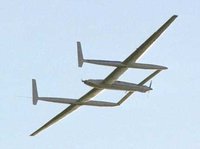Scaled Composites Voyager
|
|
The Scaled Composites Model 76 Voyager aircraft was the first to fly around the world without stopping or refueling. It was piloted by Dick Rutan and Jeana Yeager, who took off from Edwards Air Force Base's 15,000 foot (4,600 m) runway in the Mojave Desert on December 14, 1986. Their flight ended successfully 9 days, 3 minutes and 44 seconds later, on December 23. They flew 26,366 statute miles (the FAI accredited distance is 40,212 km) at an average altitude of 11,000 feet (3.4 km). This broke a previous record set by a United States Air Force crew piloting a Boeing B-52 that flew 12,532 miles (20,168 km) in 1962.
Voyager's takeoff took place at 8:01 AM local time. As the plane accelerated, the tips of the wings, which were heavily loaded with fuel, were damaged as they scraped against the runway (see photo below), ultimately causing pieces to break off at the ends. The aircraft accelerated very slowly and needed approximately 14,200 feet (4.3 km) of the runway to gain enough speed to lift from the ground. During the flight, the two pilots had to deal with extremely cramped quarters. To reduce stress, the two attempted to fly the plane in three-hour shifts, but this did not prove to be very successful and they became extremely fatigued.
VoyagerAircraftWingtipAtNASM.jpg
The plane also continuously reminded the pilots of its fragility. They had to maneuver around weather numerous times, most perilously around the 600 mile (1,000 km) wide Typhoon Marge. Libya denied access to the country's airspace, forcing precious fuel to be used. As they neared California to land, a fuel pump failed and had to quickly be swapped with its twin on the other side of the aircraft. The plane safely came back to Earth, touching down at 8:06 AM at the same airfield. The average speed for the flight was 116 miles per hour (187 km/h).
VoyagerAircraftAtNASM.jpg
The aircraft was first dreamed up by Dick and his brother Burt Rutan as they were at lunch in 1981. Like many other inventions, the initial idea was first scratched out on a napkin. Burt continued to refine the design. The craft, largely made of fiberglass, graphite, and Kevlar, weighs 939 pounds (426 kg) when empty. However, when it was fully loaded before the historic flight, it weighed 9,694.5 pounds (4397.3 kg). The plane had front and rear propellers, powered by separate engines. The rear engine, a water-cooled Teledyne Continental IOL-200, was operated throughout the flight. The front engine, an air-cooled Teledyne Continental O-240, was operated intermittantly to provide additional power for takeoff and climbing. Voyager was built in Mojave, California, at Burt Rutan's Scaled Composites facility, over a period of 5 years. It is now on display at the Smithsonian Institute's National Air and Space Museum in Washington, DC.
See Also
- The Virgin Atlantic GlobalFlyer was a jet-powered aircraft also designed by Burt Rutan, in which Steve Fossett made the first solo nonstop flight around the world in 2005.
References
- David H. Onkst. Dick Rutan, Jeana Yeager, and the Flight of the Voyager. (http://www.centennialofflight.gov/essay/Explorers_Record_Setters_and_Daredevils/rutan/EX32.htm) U.S. Centennial of Flight Commission.
|
Lists of Aircraft | Aircraft manufacturers | Aircraft engines | Aircraft engine manufacturers Airports | Airlines | Air forces | Aircraft weapons | Missiles | Timeline of aviation |

